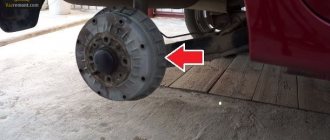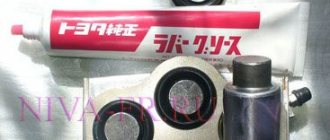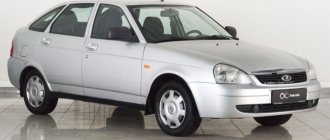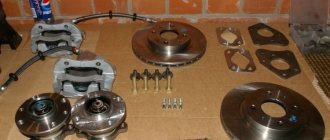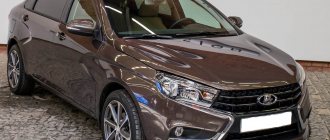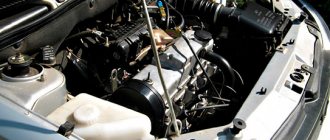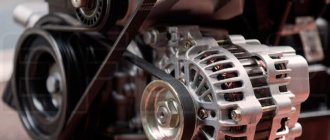Which brake drums are better, cast iron or aluminum? Read for everyone
Rear drum brakes are still quite common (although there are now quite a few disc options). This is done for the sake of saving production on the one hand. And for longer operation on the other hand, on the consumer side (they last at least 30 - 40% longer than the opponent). However, their braking is definitely worse, and the rear disc brakes look visually better. By the way, we discussed the pros and cons here . However, drum systems are not as simple as they seem; the difference may be the material. At the moment, it is possible to distinguish between aluminum and cast iron options. We’ll talk about them now...
THE CONTENT OF THE ARTICLE
You can often find information on the Internet that the cast iron drum system is outdated and is not used often. But on the contrary, aluminum is advanced and is now installed everywhere! But this is not entirely true; brake drums are now used approximately 50/50. And some manufacturers are not moving away from cast iron, and there are good reasons for this. Let's talk about them.
see also
Brake pad wear
- 4 0 2k
Brake cleaner
- 4 2 20k
Uneven pad wear
- 29 1 21k
Pads squeak when braking
- 176 1 157k
Brakes jerkily
- 71 0 81k
Lada Kalina cars of both generations have front disc brakes and rear drum brakes. As unique front brake pads for Kalina 1, the catalogs indicate 21100-3501080-00 and 21100-3501080-01, for Lada Kalina 2 the article number is 11180-3501080-00. The same catalog numbers are used for Lada Priora.
Factory brake pads TIIR
Rear drum brake pads are specified as 21080-3502090-01 or 11180-3502090-10 (with ABS) for Kalina 1 and 2.
Almost all of these part numbers are invalid; instead, online spare parts stores provide the rest with unique catalog numbers or analogues. This makes sense, since in the case of the Lada Kalina (and LADA in general), the original is often inferior in quality to its substitutes .
Aluminum brake drums
Now they are the most advanced. Why? Yes, they simply weigh little, and manufacturers are trying their best to lighten the weight of the car and, in particular, reduce the load on the axle.
Therefore, this material is now being used more and more often, what other advantages are there:
But this system also has disadvantages and they are also significant, let’s take it in order.
To be honest, aluminum drums are not as durable a product as, say, cast iron. They really break very easily. Let’s say your rear wheel is stuck, the brake lining is torn off due to high wear, you won’t be able to just remove it and look inside, and if you hit it with a hammer, you’ll simply break the drum. In this regard, the opponent looks much more profitable.
What tools are needed to replace pads?
Replacing pads is a simple operation, so there is nothing exotic in the set of tools and materials. All you need is:
- Knitted gloves and rags.
- Car jack.
- Wheel chocks.
- Wheel wrench (balloon).
- Keys for 17 open-end, and for 14 cap.
- Slotted screwdriver.
- Soft brush for metal.
- Adjustable pliers or extendable pliers, with a grip of up to 60 mm.
- A bulb for collecting excess brake fluid.
- 50 cm of wire or cord.
- Lubricant for guide bolts.
Pliers or pliers are needed to press the brake piston into the cylinder. A tool is not needed every day. Therefore, you don’t have to buy it specifically. You can drown the piston in another way.
Cast iron brake drums
Needless to say, this metal is much stronger, but also many times heavier than its opponent. Some manufacturers sacrifice suspension lightweighting and still install cast iron on their cars.
There are a number of reasons for this, but as you probably guessed, they stem from the competitor’s disadvantages, let’s list:
That's all! Of course there are more disadvantages.
By the way, here is a short video after painting such a drum.
So which is better?
What to choose in the end so as not to make a mistake? Guys, I’ll say that very few people now change aluminum to cast iron in drums or vice versa, most likely the replacement will be with disc brakes (they are really better), and ventilated or even perforated , it has been proven that with these the car brakes 15 - 20% more efficiently.
And the choice between these two, I personally would fall on cast iron, but it needs to be tinted, and it’s heavier, a pair is about 8-10 kilograms, but it’s more reliable and easier to remove. This is my personal opinion.
I’ll end here, read our AUTOBLOG
(
18 votes, average: 4.17 out of 5)
Similar news
Brake fluid composition. Basic properties, necessary information
What is and how does a brake caliper work? Let's look at the main problem.
How and with what paint to paint the brake drums. So as not to rust.
Source
Entry three. Brakes.
In this post we will talk about rear brakes.
Not long ago I began to notice that the rear brakes began to over-braking and make rustling sounds when braking. Over-braking the rear axle in icy conditions does not cause any positive emotions, and even more so if your wife is driving. Therefore, it was decided to quickly look for the cause. When I bought the car, I promised myself and everyone around me that in the near future I would only drive, and do only the most necessary things, without fanaticism. Yeah... Figurines. The poet’s soul couldn’t stand it... A plan was immediately born in my head about what needed to be changed. Absolutely everything was replaced except the hub itself and the handbrake cables. As they say, change is change :) On the first trip after buying the car, I had a strong feeling that it was time for the rear wheel bearings to retire. As a result, the list of necessary things included: 1. Rear wheel bearings 2. Rear brake pads (preferably ATE) 3. Rear brake cylinders (preferably ATE) 4. Brake drums (only factory and nothing else) After going to the store, I was a little puzzled , because for a viburnum with ABS the choice of brake pads is quite small. To be more precise, only two companies. Either the factory or NIPPON. I came home and started smoking viburnum forum. And in fact, there is no choice. And the culprit is the ABS sensor, which is visible through the brake pad. Well, in the end I decided to buy NIPPON. I went to the store and bought: 1. Rear wheel bearings SS-20 At first impressions, the bearings left positive emotions. Beautifully packaged, nut as a gift, detailed installation instructions.
2. NIPPON rear brake pads. At first I thought the company was so-so. It turned out to be a Japanese company (well, of course I don’t know if it’s Japan, but something like that). I also liked how everything was packaged, everything was beautiful, napkin, instructions, etc.
3. Rear brake cylinders ATE.
4. Brake drums factory.
On the weekend I went to the garage and got to work. The process is the simplest, so there is no point in describing it.
During the analysis, it turned out that everything feels very good, nothing is leaking anywhere, nothing is rubbing, and everything is in its place, the pads are not even worn out. The only thing was that the cylinders were a little sour, but they worked fine. What was I doing for nothing? Everything can be replaced, without any dispute about who is to blame and who is not.

